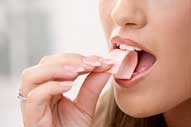How does botox really work? Botox acts on the muscle its injected into by relaxing and reducing the strength of contractions. It is a highly refined purified protein with absolutely no live bacteria that lasts approximately 3-6 months. As the effects of Botox wear off, strength gradually returns to the contraction of the muscle affected.
Therapy with Botox for Grinding, Clenching, and TMJ Disorder
Many people grind and clench their teeth and/or suffer from TMJ Disorder. Your teeth should only touch together approximately 30 minutes a day, for chewing and swallowing. People that grind and clench put their teeth together more then 30 minutes a day. The hyper-function of the muscles used to move the jaw and put the teeth together can lead to: excessive wear to the teeth, broken teeth, inflammation/hypertrophy of muscles used to move jaw, TMJ Disorder, and headaches. Treating a patient with Botox in combination with a night guard can significantly reduce the symptoms from hyper-function of these muscles.Gummy Smiles
Some patients have excessive gum tissue showing when they smile or talk. This could be due to excessive jaw growth, short upper lip, hyper-function of upper lip muscles, and/or altered gum tissue growth. Patients will sometimes go through gum or jaw surgery to reduce a “gummy smile.” An non-invasive alternative treatment option to treat “gummy smiles” is injecting botox into the upper lip muscles that produce a smile. By relaxing these muscles of facial expression with botox, the amount of gum tissue exposed when smiling is reduced.Wrinkles
Wrinkles are caused by muscles that fold the skin overlying. When the contraction of the muscles that cause facial
expressions are reduced, wrinkles are reduced or go away completely by allowing the skin to recover. Dentists are experts in the anatomy of the head/neck region and are excellent sources for injections in the area. An added benefit is that patients typically see the dentist for routine cleanings every 6 months, the perfect time to have the Botox re-done.
]]>
When the contraction of the muscles that cause facial
expressions are reduced, wrinkles are reduced or go away completely by allowing the skin to recover. Dentists are experts in the anatomy of the head/neck region and are excellent sources for injections in the area. An added benefit is that patients typically see the dentist for routine cleanings every 6 months, the perfect time to have the Botox re-done.
]]>

 It’s hard to resist eating the candy intended for the big day before Halloween actually arrives. Then there’s the question of what do you do with all the left over candy that wasn’t given out, or the haul from “Trick-or-Treating!”
Here’s our advice– Halloween is a fun time, so enjoy it. Just keep some of these tips in mind to help minimize the risk of getting cavities:
-Try to avoid really sticky candies like caramels and taffies. These types of candies typically get into the nooks and crannies of your teeth that are hard to clean.
-Give yourself or your child a set number of pieces of candy you can eat per day as to limit the sugar intake each day.
– Try and limit the number of times you expose your teeth to candy in a day. It is better to eat multiple pieces at once, rather than one piece at time, multiple times during the day.
– Try to brush and floss after snacking on candy.
– If you’re unable to brush and floss, try and drink water. Although it won’t clean all of the sugar away from your teeth and is not a guarantee that you won’t get cavities, it will help cleanse your mouth, helping to reduce the possibily of cavities. Sugar-free gum is also another good trick. Like water, it helps to remove residual sugar from your mouth, while also stimulating saliva flow. Saliva is a natural protector against cavities.
Happy Halloween!]]>
It’s hard to resist eating the candy intended for the big day before Halloween actually arrives. Then there’s the question of what do you do with all the left over candy that wasn’t given out, or the haul from “Trick-or-Treating!”
Here’s our advice– Halloween is a fun time, so enjoy it. Just keep some of these tips in mind to help minimize the risk of getting cavities:
-Try to avoid really sticky candies like caramels and taffies. These types of candies typically get into the nooks and crannies of your teeth that are hard to clean.
-Give yourself or your child a set number of pieces of candy you can eat per day as to limit the sugar intake each day.
– Try and limit the number of times you expose your teeth to candy in a day. It is better to eat multiple pieces at once, rather than one piece at time, multiple times during the day.
– Try to brush and floss after snacking on candy.
– If you’re unable to brush and floss, try and drink water. Although it won’t clean all of the sugar away from your teeth and is not a guarantee that you won’t get cavities, it will help cleanse your mouth, helping to reduce the possibily of cavities. Sugar-free gum is also another good trick. Like water, it helps to remove residual sugar from your mouth, while also stimulating saliva flow. Saliva is a natural protector against cavities.
Happy Halloween!]]>  Miles away from home and in unfamiliar surroundings and it hits you– your previously perfect tooth has just shattered and is now throbbing uncontrollably. Now what?
Traveling in the US?
– First step, call your dentist, they may have some words of advice for your particular problem. Also, depending on your circumstances they may be able to call in a prescription if necessary or direct you to a nearby facility to help you.
– If your dentist is unavailable and you’re at a hotel, utilize your concierge or front desk staff. Often times they will have a list of people in the area that they have on call for emergency medical and dental situations.
– If neither options are available, contact the local hospital. Mostly likely a dentist or oral surgeon will be on call to help you with your emergency.
Traveling out of the Country?
– As previously mentioned, contact your dentist immediately. Unfortunately, he/she will not be able to prescribe you any medications overseas but may be able to give you advice on how to proceed. Also, check-in with your concierge for local resources as you would in the U.S.
– If you don’t feel comfortable with your hotel’s concierge or don’t have a great grasp of the language and resources available to accomodate you, you may want to contact services at the U.S. Embassy. They may be able to put you in touch with medical services and help with transferring funds from the U.S.
– We also advise you contact your insurance company before a trip abroad to see if there are any policies about coverage outside of the country.]]>
Miles away from home and in unfamiliar surroundings and it hits you– your previously perfect tooth has just shattered and is now throbbing uncontrollably. Now what?
Traveling in the US?
– First step, call your dentist, they may have some words of advice for your particular problem. Also, depending on your circumstances they may be able to call in a prescription if necessary or direct you to a nearby facility to help you.
– If your dentist is unavailable and you’re at a hotel, utilize your concierge or front desk staff. Often times they will have a list of people in the area that they have on call for emergency medical and dental situations.
– If neither options are available, contact the local hospital. Mostly likely a dentist or oral surgeon will be on call to help you with your emergency.
Traveling out of the Country?
– As previously mentioned, contact your dentist immediately. Unfortunately, he/she will not be able to prescribe you any medications overseas but may be able to give you advice on how to proceed. Also, check-in with your concierge for local resources as you would in the U.S.
– If you don’t feel comfortable with your hotel’s concierge or don’t have a great grasp of the language and resources available to accomodate you, you may want to contact services at the U.S. Embassy. They may be able to put you in touch with medical services and help with transferring funds from the U.S.
– We also advise you contact your insurance company before a trip abroad to see if there are any policies about coverage outside of the country.]]>  Have you ever wondered if the claims about certain sugar-free chewing gums are true and can in fact help prevent cavities? And, if so, why? Is it a special type of sugar, like xylitol, or is it from the process of just chewing gum?
There is a lot of research about the benefits of chewing sugar-free gum that shows chewing sugar-free gum for 20 minutes following meals does in fact help with the reduction of cavities. Although many studies do say that xylitol can help in reducing cavities, the largest reason why chewing sugar-free gum can help is because of the role it plays in producing more saliva.
When you chew sugar-free gum, there is no sugar present to be broken down in the mouth so there is no food for the bacteria that causes cavities to eat. The process of chewing gum increases the amount of saliva in your mouth. Saliva plays a huge role in keeping your mouth clean and healthy. By increasing the flow of saliva in your mouth, your teeth become more resistant to cavities by letting all the important ingredients to your saliva, such as calcium and phosphate, bathe your teeth and in turn strengthen tooth enamel.
So, it is true! Chewing sugar-free gum can help reduce your risk for cavities.
If you are able to chew gum and consume artificial sweeteners then remember, everything within moderation and be sure to look for chewing gum that has the ADA Seal of Acceptance on the back.
Have you ever wondered if the claims about certain sugar-free chewing gums are true and can in fact help prevent cavities? And, if so, why? Is it a special type of sugar, like xylitol, or is it from the process of just chewing gum?
There is a lot of research about the benefits of chewing sugar-free gum that shows chewing sugar-free gum for 20 minutes following meals does in fact help with the reduction of cavities. Although many studies do say that xylitol can help in reducing cavities, the largest reason why chewing sugar-free gum can help is because of the role it plays in producing more saliva.
When you chew sugar-free gum, there is no sugar present to be broken down in the mouth so there is no food for the bacteria that causes cavities to eat. The process of chewing gum increases the amount of saliva in your mouth. Saliva plays a huge role in keeping your mouth clean and healthy. By increasing the flow of saliva in your mouth, your teeth become more resistant to cavities by letting all the important ingredients to your saliva, such as calcium and phosphate, bathe your teeth and in turn strengthen tooth enamel.
So, it is true! Chewing sugar-free gum can help reduce your risk for cavities.
If you are able to chew gum and consume artificial sweeteners then remember, everything within moderation and be sure to look for chewing gum that has the ADA Seal of Acceptance on the back.
 In today’s health conscious world, there is an increasing focus on maintaining a healthy mind as well as body. Studies now show just how complex our bodies are and how important daily maintenance is.
One topic that I find very interesting and important is the link between periodontal disease and heart disease. Cardiovascular disease affects more than 80 million people in the United States alone. It can present itself in the form of high blood pressure, heart attacks, angina pectoris, strokes or even heart failure. Periodontal disease, in the dental world is also incredibly prevalent.
Periodontal disease is the chronic inflammation and infection of the gums and surrounding tissues. Periodontal or gum disease can involve gingivitis (the inflammation of the gum tissue) or periodontitis (the loss or recession of bone aroud the teeth).
So what’s the connection?
Recent studies have found that the bacteria and inflammatory proteins that are present in gum disease are associated with an increase of blood vessel wall thickening, which is often found in cardiovascular disease.
The theory is that the bacteria and inflammatory proteins found in the mouths of people with periodontal disease make their way to the blood stream where they begin to affect the cardiovascular system.
How does this effect you?
Having good oral health is something we should all strive for, however, if you are at risk for, or have a family history of cardiovascular disease then you should be even more diligent with your oral hygiene. That means flossing and brushing regularly and seeing your dentist at least every 6 months. If you have periodontal disease be sure to tell your physician as well.]]>
In today’s health conscious world, there is an increasing focus on maintaining a healthy mind as well as body. Studies now show just how complex our bodies are and how important daily maintenance is.
One topic that I find very interesting and important is the link between periodontal disease and heart disease. Cardiovascular disease affects more than 80 million people in the United States alone. It can present itself in the form of high blood pressure, heart attacks, angina pectoris, strokes or even heart failure. Periodontal disease, in the dental world is also incredibly prevalent.
Periodontal disease is the chronic inflammation and infection of the gums and surrounding tissues. Periodontal or gum disease can involve gingivitis (the inflammation of the gum tissue) or periodontitis (the loss or recession of bone aroud the teeth).
So what’s the connection?
Recent studies have found that the bacteria and inflammatory proteins that are present in gum disease are associated with an increase of blood vessel wall thickening, which is often found in cardiovascular disease.
The theory is that the bacteria and inflammatory proteins found in the mouths of people with periodontal disease make their way to the blood stream where they begin to affect the cardiovascular system.
How does this effect you?
Having good oral health is something we should all strive for, however, if you are at risk for, or have a family history of cardiovascular disease then you should be even more diligent with your oral hygiene. That means flossing and brushing regularly and seeing your dentist at least every 6 months. If you have periodontal disease be sure to tell your physician as well.]]>  Even America’s taste in beauty has changed over the years. In general, we’ve moved away from the windswept and overprocessed looks of the 70’s, 80’s and 90’s as seen with Michelle Pfiefer, Cindy Crawford and Farrah Fawcett, to focus on fresh-faced, more natural looking women like Jennifer Aniston, Jessica Alba and Angelina Jolie.
The New Vs. The Old Standards of Beauty:
Even America’s taste in beauty has changed over the years. In general, we’ve moved away from the windswept and overprocessed looks of the 70’s, 80’s and 90’s as seen with Michelle Pfiefer, Cindy Crawford and Farrah Fawcett, to focus on fresh-faced, more natural looking women like Jennifer Aniston, Jessica Alba and Angelina Jolie.
The New Vs. The Old Standards of Beauty:
 Whitening kiosks usually promise results of achieving “at least four shades lighter in less than an hour.” In order to achieve these promised results in a limited amount of time, a professional strength whitening agent with a high hydrogen peroxide content must be used. At that high concentration, you are at a higher risk of chemical burn of the gums, sensitivy or damage to your teeth.
Whitening procedures should always be done under the supervision of a dentist. Although the people at these kiosks may be wearing white coats, they are far from dental professionals. Usually they are unsupervised technicians working without the consultation of dental professionals.
The way kiosks get around the legal implications of performing this procedure unsupervised is that they instruct the “patient” how to place the bleaching agent on their own teeth, rather than place it them themselves. Since they don’t actually do the procedure themselves, they’re absolved from the legal implications of any negative side effects that may result.
It is Frangella Dental’s recommendation that whitening procedures be performed under a dentist’s supervision in a sterile environment. A dentist assesses each patient on an individual basis and predicts the outcome of treatment and any possible dangers.]]>
Whitening kiosks usually promise results of achieving “at least four shades lighter in less than an hour.” In order to achieve these promised results in a limited amount of time, a professional strength whitening agent with a high hydrogen peroxide content must be used. At that high concentration, you are at a higher risk of chemical burn of the gums, sensitivy or damage to your teeth.
Whitening procedures should always be done under the supervision of a dentist. Although the people at these kiosks may be wearing white coats, they are far from dental professionals. Usually they are unsupervised technicians working without the consultation of dental professionals.
The way kiosks get around the legal implications of performing this procedure unsupervised is that they instruct the “patient” how to place the bleaching agent on their own teeth, rather than place it them themselves. Since they don’t actually do the procedure themselves, they’re absolved from the legal implications of any negative side effects that may result.
It is Frangella Dental’s recommendation that whitening procedures be performed under a dentist’s supervision in a sterile environment. A dentist assesses each patient on an individual basis and predicts the outcome of treatment and any possible dangers.]]>  If it’s decided that your child needs orthodontic treatment, traditional braces are the most common way to straighten a child’s teeth from ages 8 to12 years old.
For teenagers, there is an alternative to braces called Invisalign. Invisalign moves the teeth using clear aligners. The clear aligners are removable so that they can be taken out for eating, drinking, and social events. In order for your child to be considered for Invisalign, his/her mouth must have fully transitioned from baby teeth to permanent teeth, which is typically complete by 12 years old for most children.
Because Invisalign is removable, teenagers may have compliance issues with the treatment. I often find teens with responsible personalities that truly do want to straighten their teeth to be the most successful with treatment.
For additional information on treatment options or to schedule a consultation, call us at (212) 245-2888.]]>
If it’s decided that your child needs orthodontic treatment, traditional braces are the most common way to straighten a child’s teeth from ages 8 to12 years old.
For teenagers, there is an alternative to braces called Invisalign. Invisalign moves the teeth using clear aligners. The clear aligners are removable so that they can be taken out for eating, drinking, and social events. In order for your child to be considered for Invisalign, his/her mouth must have fully transitioned from baby teeth to permanent teeth, which is typically complete by 12 years old for most children.
Because Invisalign is removable, teenagers may have compliance issues with the treatment. I often find teens with responsible personalities that truly do want to straighten their teeth to be the most successful with treatment.
For additional information on treatment options or to schedule a consultation, call us at (212) 245-2888.]]>